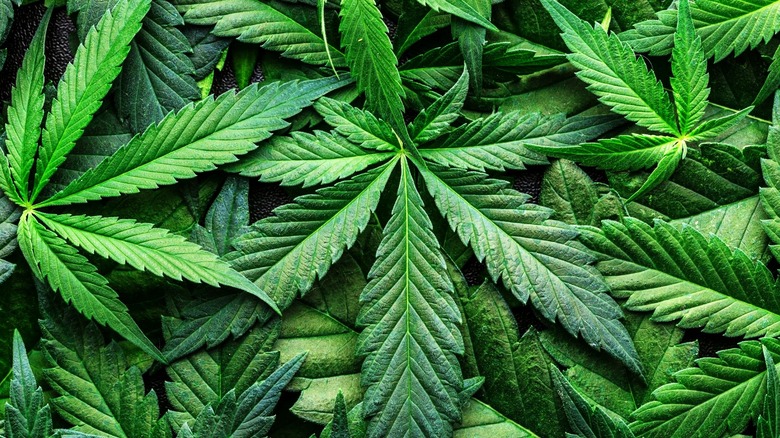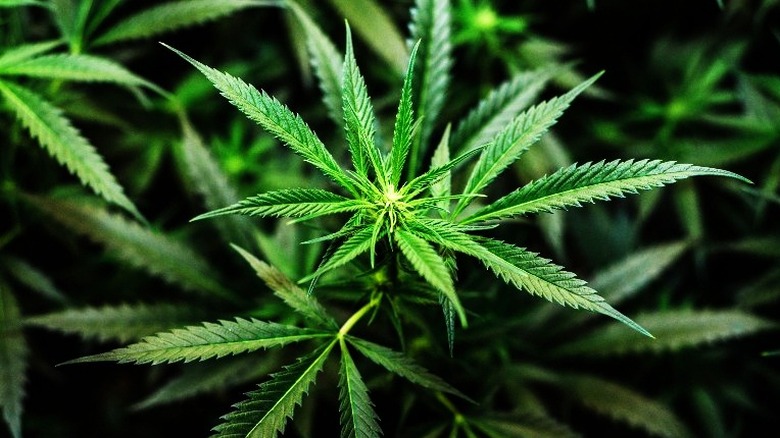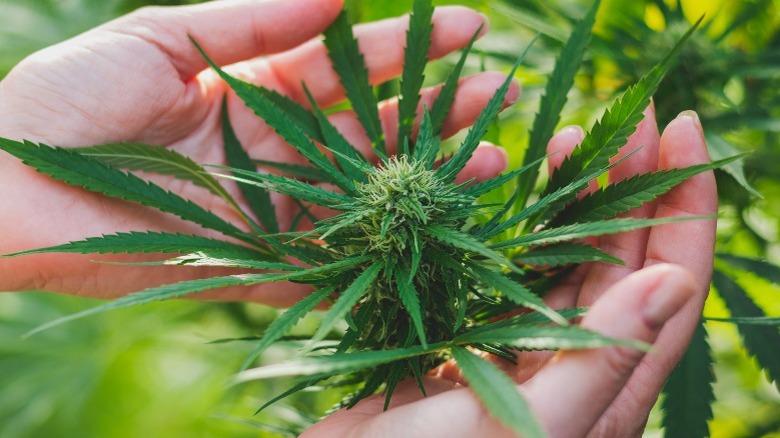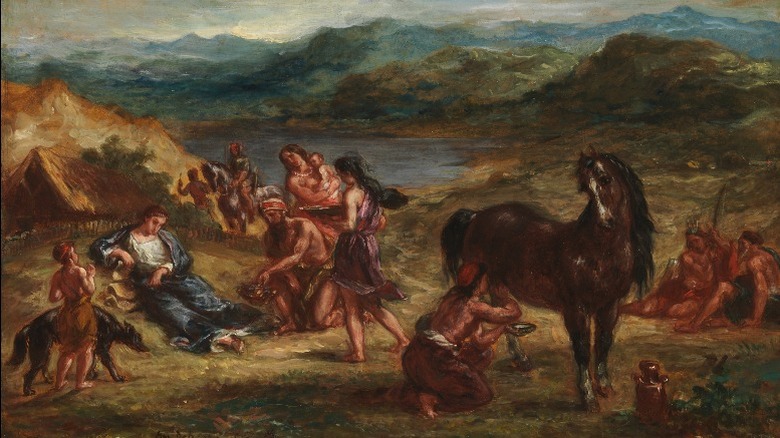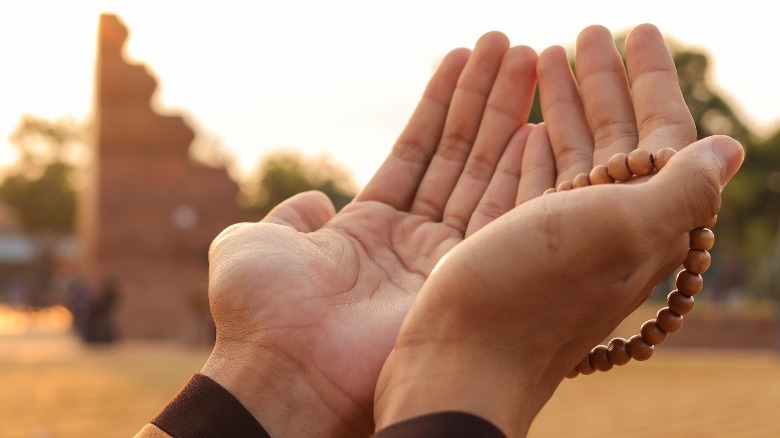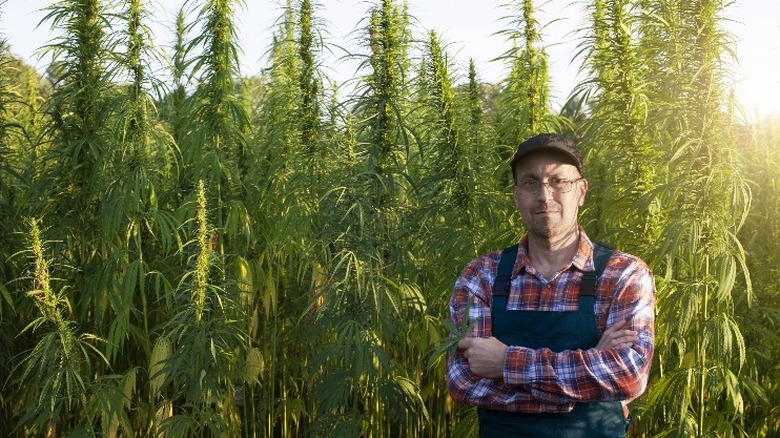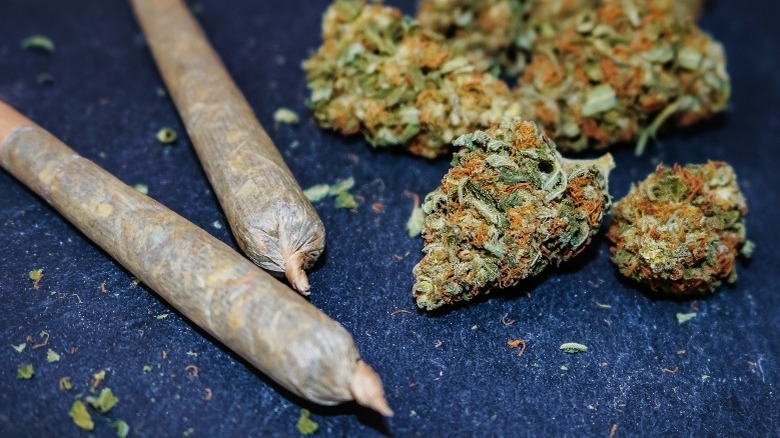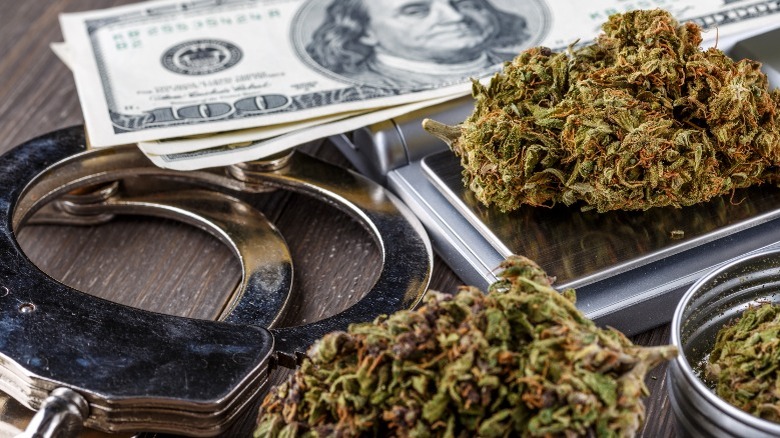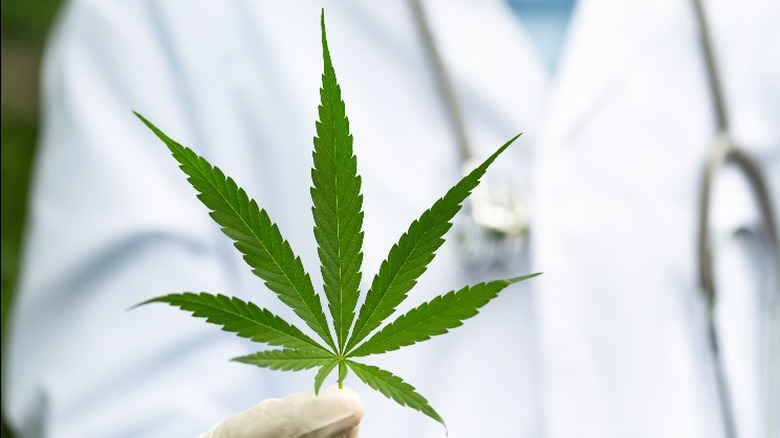Marijuana From Ancient History To Now
Marijuana. Pot. Devil's lettuce. Ganja. Dope. Hashish. Reefer. Mary Jane. Weed. The names for a certain skunky mind-altering plant are endless — and so are the complicated feelings associated with it. To some, it's a versatile medicinal herb with useful fibers. To others, it's a harmless and temporary escape from everyday stress. Plenty of people, meanwhile, consider it a dangerous gateway to drug addiction and a life of ruin. But when you boil it down, it's really just a plant. So why all the fuss?
Marijuana — more specifically the species Cannabis sativa — has long been prized for the chemical compounds found in its tissues. According to a 2021 study published in iScience, the plant produces over 1,000 compounds, including the psychoactive tetrahydrocannabinol (THC) and anti-inflammatory cannabidiol (CBD). It also contains fibers known as hemp, which have been used to make everything from paper to ship sails (per History).
The evolution of modern Cannabis sativa closely mirrors that of human civilization itself. As a 2021 study published in Science Advances observes, people started growing the species around 12,000 years ago, making it one of the earliest cultivated plants — it has been grown in some form ever since. According to the Medwell Academy, there are at least 779 different varieties of Cannabis sativa in cultivation as of 2022, though getting there was a long, strange trip indeed. Always a plant plagued by dichotomies, persisting through the ages as loved as it is hated, here is the story of marijuana from ancient history to now.
The wild ancestor of Cannabis sativa evolved in East Asia
The origin of wild Cannabis sativa has been debated for years. As a 2018 study published in Cannabis and Cannabinoid Research notes, determining when the species first evolved was complicated by the lack of fossil records. But, by examining DNA mutation rates, scientists were able to deduce that the genus Cannabis evolved around 27.8 million years ago. Curiously, its closest relative is the genus Humulus, which includes the hop plant used to make beer (per Britannica).
Scientists then studied tiny fossilized pollen grains for more clues on the species' evolution. Because Cannabis pollen is remarkably similar to that of its cousin, Humulus, botanists used habitat to determine which was which in the fossil record. They concluded that the wild ancestor of modern Cannabis sativa most likely evolved on East Asia's northeastern Tibetan Plateau, in what is now China. Scientists believe that this high-elevation steppe environment gave rise to the species' famous cannabinoids, as these compounds protected the plant from both sunlight and grassland herbivores like horses and rodents.
According to a 2022 study published in Perspectives in Plant Ecology, Evolution, and Systematics, the species then spread via animals and waterways, its range expanding and shrinking with glacial events. These events likely caused the species to split from Cannabis indica – considered by most botanists to be a subspecies — about 1.05 million years ago. Sadly, as a 2021 study published in Science Advances notes, marijuana's wild ancestor has likely gone extinct.
People started cultivating cannabis 12,000 years ago
People discovered the many benefits of Cannabis sativa pretty quickly, though its earliest uses were practical rather than recreational. According to a 2021 study published in Science Advances, genetics indicate that modern Cannabis sativa diverged from its wild ancestor around 12,000 years ago in present-day Mongolia and China, meaning this is likely where the processes of selective breeding and domestication began. Incidentally, this also makes marijuana one of the first cultivated plants.
East Asia is considered a hotspot of plant domestication and is the birthplace of many modern crops, including rice, soybeans, apricots, broomcorn, and peaches. As noted in a 2006 study published in Cell, domestication alters favorable existing traits in wild plants to better suit human needs. In the case of Cannabis sativa, plants were initially bred for their oily seeds, which served as a food crop. Later, selective breeding produced taller plants full of stem fibers, which were used to make textiles like paper, rope, and cloth.
According to a 2019 study published in Science Advances, the levels of psychoactive components in early-cultivated Cannabis sativa were low, indicating it was not yet valued as a drug plant. Sorting through history to determine how and where different varieties of the species came to be is a challenge. As a 2022 study published in Perspectives in Plant Ecology, Evolution, and Systematics notes, it's possible that there were multiple domestication sites, including one in Europe between the Caspian and Black Seas.
The Chinese used Cannabis sativa for many things
Though they originally cultivated it for its nutritious seeds, ancient China soon found many additional uses for Cannabis sativa. As Psychology Today notes, archaeologists discovered imprints of rope made from the plant pressed into old pottery — evidence that hemp was in use about 12,000 years ago. Fibers from the plant were also used to make clothing and paper, an invention that advanced Chinese culture significantly.
Growing Cannabis sativa also gave the Chinese an advantage in battle, as hemp bowstrings were greatly superior to the flimsier bamboo bowstrings used by rivals. Stronger and more durable, hemp bowstrings allowed Chinese fighters to send their arrows sailing much farther, and, as a result, hemp became the country's first war crop. But, as it turned out, sturdy fibers were only one of the plant's useful features. According to Live Science, Chinese doctors first started using Cannabis sativa to treat physical maladies around 6,000 years ago.
A few thousand years later, in 2,700 BC, Emperor Shen-Nung — known as the Father of Chinese Medicine — included Cannabis sativa in his medical encyclopedia under the name ma (per Psychology Today). Ma proved useful for treating a number of ailments, including rheumatism, constipation, gout, malaria, and, oddly enough, absent-mindedness. Later, a concoction of cannabis resins mixed with wine was administered to patients during major surgeries as a primitive anesthetic. Chinese farmers were also the first to recognize that female Cannabis sativa plants produced more of these coveted useful medicines.
People started smoking cannabis around 2,500 years ago
Figuring out exactly when people first started smoking Cannabis sativa for its psychoactive properties has baffled historians for ages. Luckily, recent findings have shed some light on the matter. According to a 2019 study published in Science Advances, researchers discovered evidence of burned cannabis within 10 wooden braziers — basically mini barbecues — found within eight tombs at the 2,500-year-old Jirzankal Cemetery in modern Tajikistan's Pamir Mountains (pictured).
What's more, the plant residue found in the braziers contained more of the psychoactive compound THC than typical wild Cannabis sativa of the time did, indicating it had possibly been selectively bred for its mind-altering effects. Researchers also observed the link between the cemetery's artifacts and the writings of the Greek historian Herodotus in his book "The Histories" — published around the same time — which described how ancient Caspian Steppe people burned cannabis using hot stones while sitting within enclosed tents. Such a setup combined with high THC content would certainly produce a pretty noticeable high.
In the case of the Jirzankal Cemetery scene, researchers concluded that cannabis was smoked during the burial, suggesting it was possibly part of a ritual designed to invoke an altered state for the purposes of communicating with deities — or the dead themselves. But because some of the tombs belonged to common people, researchers believe that the findings demonstrate that using cannabis to get high was no longer an activity reserved for society's elite, as past records implied: It had become mainstream.
Trading spread Cannabis sativa throughout the Old World
For one reason or another, Cannabis sativa proved to be a useful plant, and people started trading it pretty much as soon as it was domesticated. According to a 2022 study published in Perspectives in Plant Ecology, Evolution, and Systematics, nomadic people first moved the species outside of modern-day China and the Caucasus region — two areas where it was widely cultivated — starting around 10,000 years ago.
As noted in a 2014 study published in Geographical Review, wandering tribes like the Phrygians and Scythians frequently traveled the Silk Road, carrying the plant with them. The Scythians especially enjoyed cannabis, cultivating it, smoking it regularly during rituals, and trading it with anyone they met. In his book "The Histories," Greek historian Herodotus described their enjoyment thusly: "They take some hemp seed, creep into the tent, and throw the seed on to the hot stones. At once it begins to smoke, giving off a vapour unsurpassed by any vapour-bath one could find in Greece. The Scythians enjoy it so much that they howl with pleasure."
By way of their far-reaching travels, the Scythians brought Cannabis sativa to Eastern Europe, South Asia, and the Middle East. Starting around 2,000 years ago, the drug variety of Cannabis sativa spread into Africa and Southeast Asia by way of the Indian and Arab Empires, while hemp-use cannabis made its way to Europe. Europeans did not seem as taken with the drug, preferring to stick with wine and beer instead.
The Hindus incorporated Cannabis sativa into their religion
Many others also took a strong liking to Cannabis sativa. In fact, the Hindus enjoyed it so much that they made it an important part of their religion. As History notes, Hinduism likely began around 3,000 to 4,000 years ago in the Indus Valley of modern-day Pakistan. It's always been a melting pot of tenets and traditions rather than a conventional religion with a single founder, and one custom its believers adopted was cannabis use.
Starting around 2,500 years ago, the Hindus began to pay homage to several deities, including Devi, Vishnu, and Shiva. Per Healthline, they also started consuming bhang, an edible paste made from female Cannabis sativa plants that can be added to a variety of foods and drinks. Bhang is prized for both its psychoactive and medicinal properties and is said to reduce nausea. According to the University of Sydney, bhang is also the preferred food of Shiva — the main god of many Hindu sects — and even earned him the name The Lord of Bhang.
Ancient Hindus attributed the medicinal qualities imparted by bhang as a reflection of Shiva's approval. Likewise, health afflictions meant that Shiva or another god was displeased with a person's behavior. A fever, for example, was deemed the "hot breath of the gods," and treating it required performing a ceremony and consuming cannabis as an appeal to the deities. This would often do the trick, as it just so happens that THC lowers body temperature.
Islam circulated Cannabis sativa throughout the Middle East
Another group that took to Cannabis sativa was the Muslims. As History notes, Islam started around 1,400 years ago in what is now Saudi Arabia. Its followers — called Muslims — worship a single god known as Allah and abide by a religious text called the Koran. According to a 1982 study published in the Bulletin of the New York Academy of Medicine, Cannabis sativa first became affiliated with Islam around 1,000 years ago, when Persian and Iraqi sects at the eastern edge of the Islamic Empire got their first taste of the drug.
A few centuries later, cannabis — called hashish in Arabic — was commonplace in Islamic culture. The Koran didn't expressly forbid it as it did alcohol use, so more and more Muslims began partaking of the edible drug. The Sufis — a mystical faction of Islam — claimed that hashish brought enlightenment and a closer connection with Allah and quickly spread the plant throughout the Middle East. Muslims also valued cannabis for its medicinal qualities, using it to stimulate appetite and relieve everything from epilepsy to pain to dandruff.
Hashish became especially popular in Egypt, where it was used by the oppressed and rulers alike. But by the 14th century, a few Egyptian leaders viewed the drug as a threat to society and made serious efforts to curb its use. Plants were burned, taxes were imposed, and users were penalized. Many Muslims also revisited the Koran, reinterpreting its text to include hashish as a forbidden substance akin to alcohol — but hashish endured.
The Vikings traveled overseas with Cannabis sativa
Sea travel made Cannabis sativa a global phenomenon and was facilitated by the group perhaps most renowned for their maritime exploits: the Vikings. As Britannica notes, the fierce Scandinavian Vikings held sway over Europe from the 9th to 11th centuries, using their advanced nautical skills to navigate their longboats to new lands, which they would then conquer. And along their journeys, they carried a stash of weed.
According to a 2014 study published in Geographical Review, Cannabis sativa seeds were found aboard old Viking ships in the mid-9th century, over 1,000 years ago. But exactly what were the seafaring barbarians doing with the plant? As a 2013 study published in Scientific Reports notes, hemp fibers were especially useful for making rope and sailcloth — two things essential for sea travel. It was also used in elaborate Scandinavian wall hangings, likely because it produced better fibers than flax when grown in nitrogen-rich Nordic soil.
The Vikings also took advantage of the plant's medicinal benefits. As University of Kansas geography professor Barney Warf told Live Science, the sea warriors used cannabis to treat pain on their travels, such as that from childbirth and toothaches. To date, there's no hard evidence that the Vikings partook of the mind-altering aspects of the plant, though, as Live Science notes, in 2018 cannabis pollen was discovered at a former Viking outpost in Newfoundland, Canada, meaning they definitely carried it farther and wider than researchers previously thought.
The Puritans brought hemp to the New World
It was only a matter of time before Cannabis sativa made its way to the New World. But surprisingly, its earliest widespread introduction was strictly business. According to a 2022 study published in Perspectives in Plant Ecology, Evolution, and Systematics, Europeans colonizing the New World were predominantly focused on using the vast expanse of undeveloped land to grow hemp to make rope, sailcloth, and other textiles for shipment overseas.
As Martin A. Lee notes in his book "Smoke Signals," England even passed a law requiring all American colonists to plant hemp crops, starting in 1619. The plant flourished in the New World's soil, growing much taller than it did in England. And so, Cannabis sativa became the first crop widely cultivated in America, its initial seeds planted by none other than the Puritans, an English religious group known for their strict moral code (per Britannica). Later on, George Washington even tried his hand at hemp farming.
Hemp was woven into the very fabric of early America — in fact, it probably even supplied the fabric. Everything from clothing to paper to the hangman's noose was hemp-derived, and, at one point, the fibrous plant could be used in place of money or even as a ticket overseas. It was the nation's third-largest crop until the late 1800s, when, as Farm Collector notes, steamships replaced sailboats. American hemp farming experienced one last hurrah during World War II when the need for textiles was great.
Mexican immigrants introduced recreational marijuana to the U.S.
Though Cannabis sativa was in every American's backyard at one point, no one was smoking it. As Martin A. Lee notes in his book "Smoke Signals," the drug variety of the plant first landed in Brazil in the early 1500s by way of enslaved Africans traveling with Portuguese sailors. Native South Americans — already familiar with psychoactive substances — quickly took to the drug and began smoking it during rituals. Its use soon spread across South America and into Mexico.
According to Live Science, recreational cannabis — called marijuana in Spanish — first entered the southwestern United States alongside Mexican immigrants escaping the effects of the Mexican Revolution, between 1910 and 1911. Almost immediately, the plant was viewed as a threat and by 1931, 29 states had banned its use. As a 2016 study published in U.C. Davis Law Review notes, apprehension surrounding the drug largely stemmed from racism against Mexican Americans and Black citizens of the South.
Since both groups smoked cannabis, the plant became a scapegoat for racial bias in America, with everything from rape to murder being blamed on the drug and the people who used it. In 1936, "Reefer Madness" — a blatant propaganda film (per KQED) — was released, whipping the growing flames of fury into a full-blown inferno. Just a year later, the U.S. federal government passed the Marihuana Tax Act of 1937, which banned all non-medical use of the plant.
American youths embraced marijuana in the '60s and '70s
Americans, like many cultures before them, greatly enjoyed Cannabis sativa. According to a 2017 report published by the National Academies Press, marijuana use experienced a revival in the 1960s, with many young adults regularly smoking the drug. As Britannica notes, the hippie movement of the '60s likely drove marijuana's comeback, with many middle-class white American youths shirking mainstream culture, advocating for nonviolence and free love, and enjoying spirituality and recreational drug use.
Marijuana use increased, peaking in the late 1970s. Though it was still federally illegal, this did little to deter its devoted enjoyers. In 1976, a shocking one in eight Americans over the age of 12 admitted to smoking it within the last month. Hippies in particular were fascinated by their newfound drug of choice and began delving into the complicated history of Cannabis sativa. In his travelogue, former English hippie-traveler Tony Walton described the allure of "far off, exotic lands where hash was cheap, strong, and readily available."
As The Hash Corporation notes, this led youths the world over to the Middle East and India on an odyssey that became known as The Hippie Trail. On their travels, hippies retraced the ancient Silk Road on foot, rode on "magic buses", and learned exotic new ways to enjoy the plant, such as smoking the concentrated cannabis resin known as hash (per The Seattle Times). Famous artists of the time, like The Beatles and Jimi Hendrix, also got in on the fun.
The United States' War on Drugs targeted marijuana users
But the fun was short-lived. As it turned out, the plant still had its fair share of haters. According to a 2014 study published in Geographical Review, most of the marijuana in America during the '60s and '70s came from Mexico. In an attempt to nip it in the bud (pun intended), the federal government began patrolling the Mexican-American border for drugs in 1969. In 1975 they got even more aggressive with their tactics, ruthlessly spraying herbicide on Mexican marijuana crops.
This caused weed prices to skyrocket. Unwilling to forgo the drug, a generation of amateur horticulturists started growing the plant themselves, stowing miniature greenhouse operations in basements, closets, and storage units. But everything changed in the 1980s: President Reagan launched the war on drugs in 1982, encouraging the streamlined arrest of anyone in possession of an illegal substance. But, as Rolling Stone observes, the lion's share of the policy's focus went to marijuana, while hard drugs like crack cocaine, meth, and heroin continued to infiltrate the country.
What's worse, according to a 2016 study published in U.C. Davis Law Review, the motivation for enforcement seemed to be racially motivated. Despite the prevalence of traffickers, as well as plenty of white individuals smoking pot, the majority of arrests made during the war on drugs were Latino and Black youths in possession of marijuana. Meanwhile, the disproportionate focus on marijuana allowed the growing prescription opioid epidemic to continue unchecked (per NPR).
Medical uses of marijuana were revisited
Throughout its history, one thing most cultures seem to agree on is that Cannabis sativa is a valuable medicinal plant. The western world was a little slow to embrace it, but, according to Martin A. Lee in his book "Smoke Signals," one Irish doctor finally convinced European cultures to appreciate the plant. Dr. William B. O'Shaughnessy spent years studying cannabis while stationed in India in the 1830s, shadowing Ayurvedic healers and observing its various uses.
Before long, he started doing his own experiments, administering cannabis to patients suffering from then-incurable conditions like tetanus, cholera, and rabies. He released his findings in a British scientific journal in 1842, marking the first contemporary publication extolling the medical uses of marijuana. By 1854, his "Indian hemp" was listed in the U.S. Pharmacopeia and became regarded as something of a miracle drug. Nonetheless, medical marijuana research was later stifled by negative stigma and controversy in the 1900s.
But times are changing: As a 2017 study published in Pharmacy and Therapeutics notes, modern science lists many benefits of medical cannabis. In addition to its psychoactive properties, THC lessens nausea, stimulates appetite, and prevents vomiting, making it an ideal treatment for cancer patients undergoing chemotherapy. CBD, meanwhile, combats inflammation, anxiety, seizures, and pain, but lacks the unwanted mind-altering side effects (per The New York Times). In 1996, California became the first U.S. state to legalize medical marijuana. As of 2022, 37 states have done the same (per the National Conference of State Legislatures).
The world is becoming more open to Cannabis sativa use
The world is slowly relaxing its strict views on Cannabis sativa use. As the Chicago Tribune notes, sections of North America, Africa, Australia, Europe, and South America not only allow medical applications of marijuana but have decriminalized it, meaning recreational use is also permitted. Oddly enough, most of Asia and the Middle East — two regions responsible for making the world aware of cannabis — still forbid its use.
The United States is currently in the process of dismantling past prejudices regarding the plant. According to U.S. News and World Report, Colorado became the first U.S. state to legalize recreational marijuana use in 2012. As of 2022, 21 U.S. states are doing the same. In states where marijuana is legal, it can be grown or purchased at dispensaries. Determining which variety produces a desired effect is as easy as ordering a drink at Starbucks, and CBD products are available at most gas stations.
Still, as Science notes, marijuana remains federally illegal and classified as a Schedule I drug — right up there with LSD and heroin — which makes it difficult for scientists to study it. But in December 2022, President Biden signed a bill to make it easier for researchers to obtain plants for their studies. As U.S. representative and physician Andy Harris told Science, "We will now be able to treat marijuana like we treat any other substance or pharmaceutical for which we hope there is a potential benefit."
